Everything in Openwork: Parallels RAS Integration into Microsoft Azure

Earlier we wrote that our Parallels Remote Application Server ( RAS ) was recognized by IDC analytical agency as one of the key global players in the VCC (Virtual Client Computing) market. Recently, RAS has integrated into the Microsoft Azure cloud computing environment. Under the cut a bit of pictures, marketing jelly and the results of the technical testing of our beast on various virtual machines. It would be great to get questions on the topic and stories from your personal experience with Azure + in the comments to the article about the organization of your corporate remote access.
Recall about whom (or what) is it.
')
Parallels RAS is our application and desktop virtualization system. Basically, she is interested in representatives of large, medium and small businesses who have a need to organize employee access from iOS, Android devices, through ChromeOS, HTML5, to Windows applications running on a remote server. In other words, with RAS, the phrase “we have long hands” acquires a new meaning and can be applied to you, your employees, colleagues and partners who want to work with files and documents placed on remote desktops and servers via smartphones and tablets.

Key components of RAS:
- Publishing Agent Module
- Secure Client Gateway module. Provides end users with access to RAS. Able to encrypt connections using SSL. Increased resilience and scaling are achieved by adding new gateways. Throughput - 250-500 users per gateway, depending on the selected mode.
- Terminal Server Agent Module. Allows RAS to use Microsoft RDS servers
- High Availability Load Balancer (HALB) module . Performs "carousel" balancing gateways Secure Client Gateway.
- VDI Host Agent Module . Provides the connection of the hypervisor host (VMware, Hyper-V, XenServer) to the RAS farm.
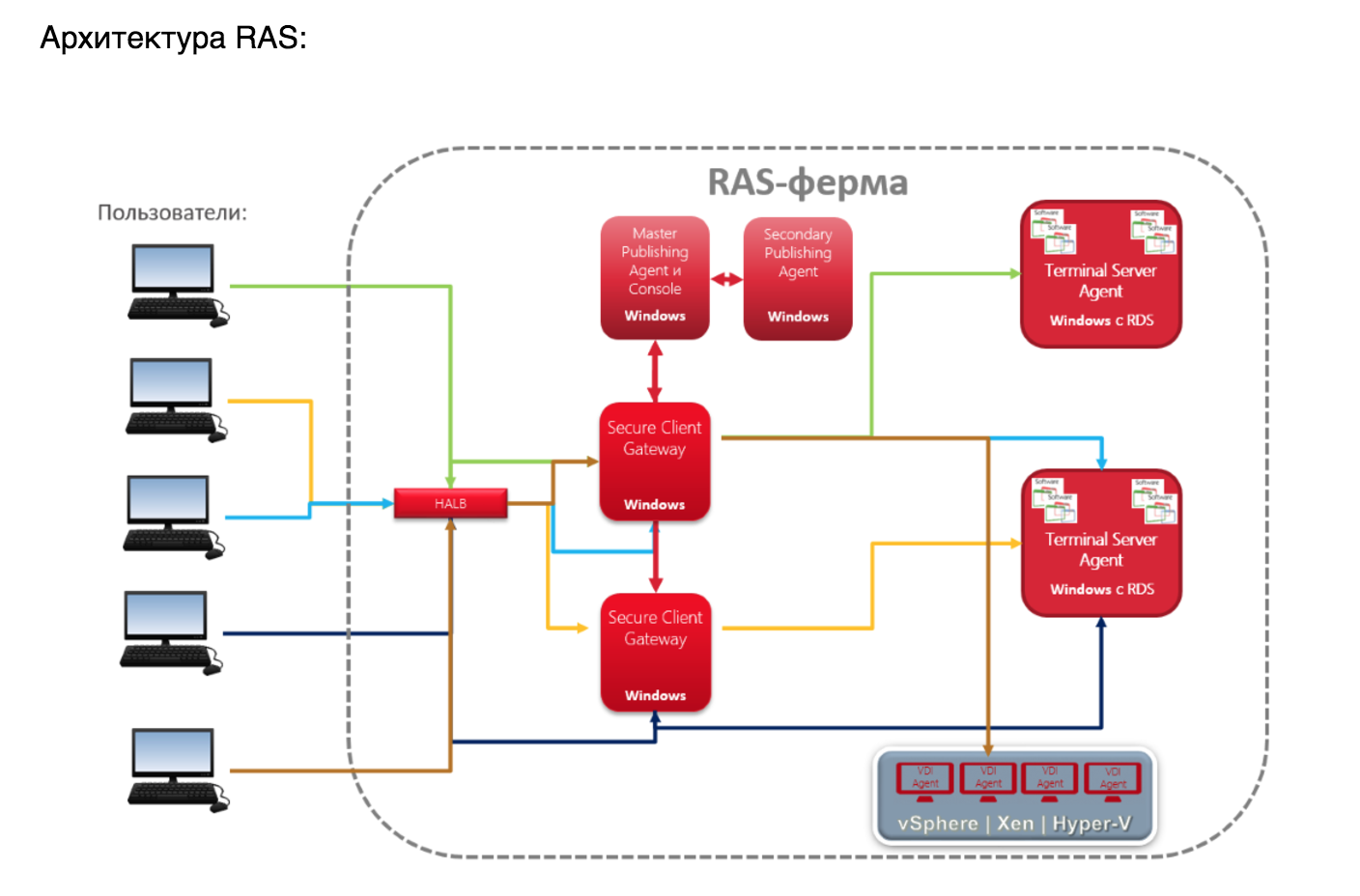
Not forgotten, and the main "weapon" of system administrators in solving any problems - reports. RAS is able to generate 14 types of reports: user (user activity, session user activity, client devices and OS); all the same, but about the group; server status and activity; use of published applications, and so on. All this information abundance can be exported in 7 different formats.
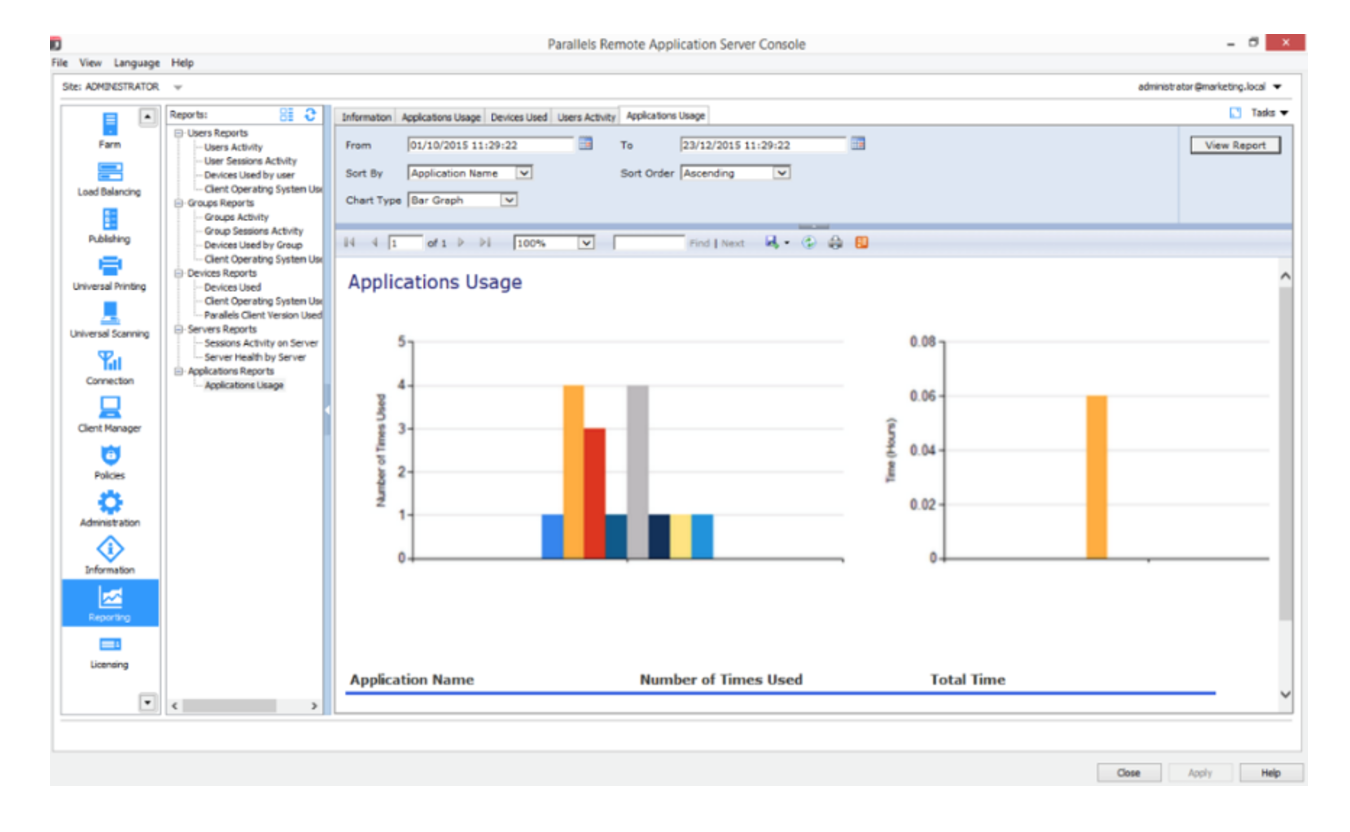
What for?
Let's return to our cherry on the cake “RAS + Azure”. Lived RAS itself by itself, why did it roll up in Azure? The goal is to simplify, speed up and cheapen the deployment of customer access to applications. Quickly. Simply. Clear. This seems to be a recipe for how RAS can take a fair market share in the world. Sorry for some pathos, but in the end, our solution allows medium and small companies to save up to 30 percent on building hardware infrastructure and quickly provide their employees with access to desktop applications from their mobile devices at any scale.
Integration architecture
When creating a virtual machine in Azure, an Azure Resource Group container is formed. All virtual machines of this container are isolated within the same virtual network.
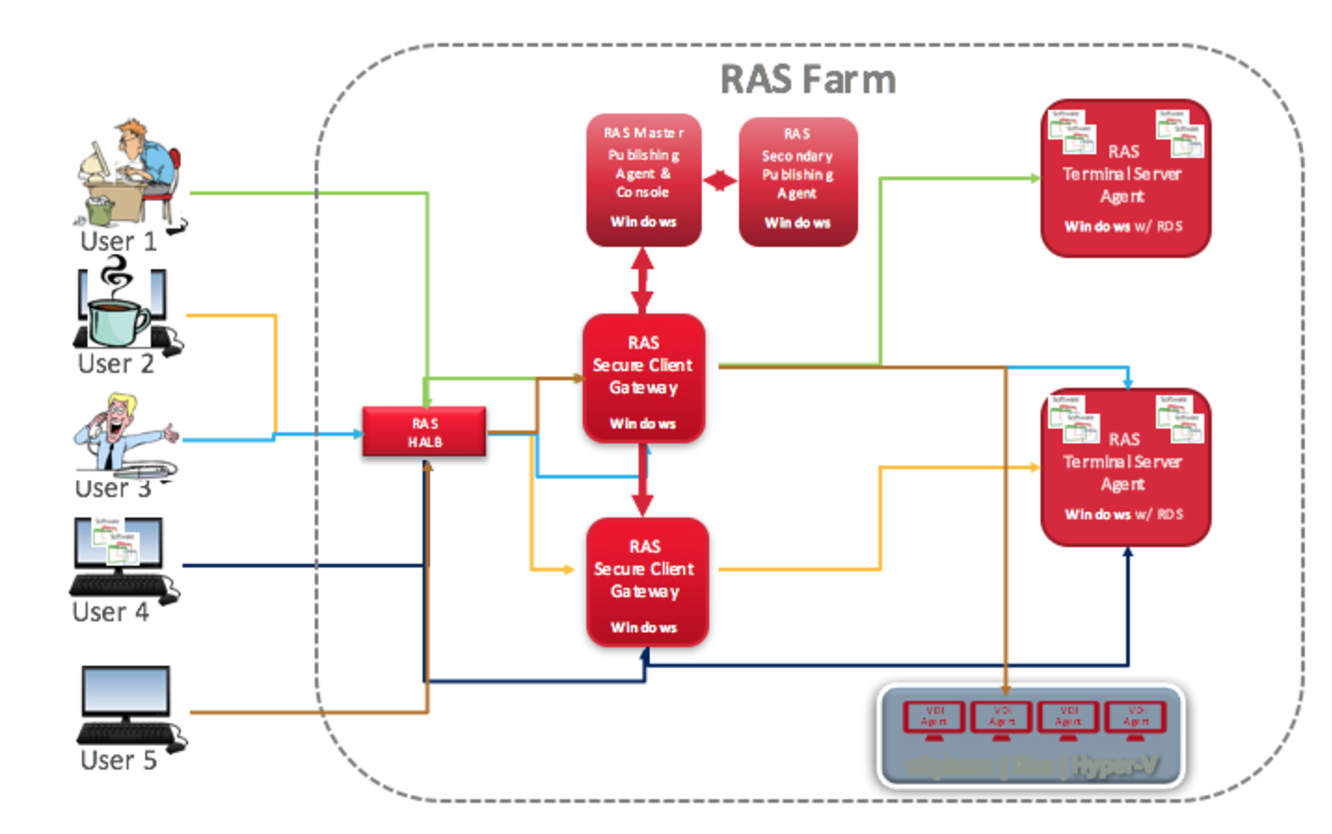
Publishing Agent modules distribute incoming connections and configure connections between end users of applications installed on terminal servers (Terminal Server, TS).
What is the use of integration?
Integrating RAS into the Azure platform, in addition to using mobile users of Windows applications in the cloud, can be useful to companies using Microsoft RDS (Remote Desktop Server). With all our respect for the Redmondians, their product has a number of features:
- Server balancing : server balancer capabilities are limited, it can only manage connections based on the number of sessions and weights assigned to servers.
- Network load balancing : the balancer can only detect network interface failures; it does not track the status of the gateway. The balancer will not know that the gateway has failed, and will continue to send requests to it.
- Non-Windows clients : RDS has no Linux clients and a web browser. So today, administrators have to put third-party solutions on top of it in order to provide Windows-based applications and desktops on Linux-based machines or in a browser without the ability to install the client.
Parallels RAS, which itself is built around the Microsoft RDP protocol, helps sysadmins do more in less time. In addition, it is so easy to set up and manage, that they can steer without any prior training.
Number of users per virtual machine
With LoginVSI, we tested and found out how many RAS users support Azure virtual machines of different series (A, D, and Dv2). The assessment was carried out for two types of workload - Task Worker and Knowledge Worker. Performance was measured throughout the session: logging in, allocating a virtual desktop to the user, processing test items (see below), logging out. To eliminate the effect of data caching on test results, the workload first spun on virtual machines for 48 minutes, and then performance was measured. For each instance of the virtual machine, three tests were performed and the average value was taken.
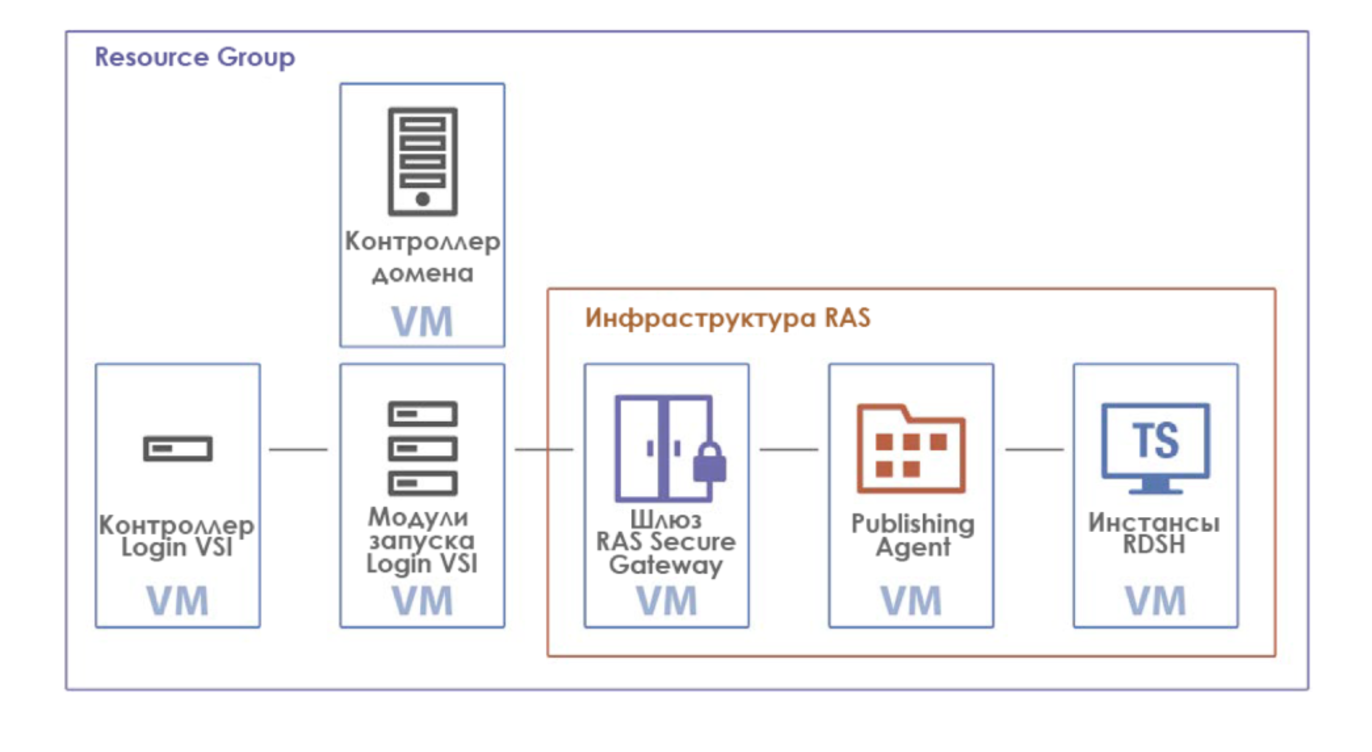
We measured:
- minimum, maximum and average response time
- CPU load
- memory consumption
- response time of the disk I / O subsystem
Workload profile Task Worker : scripts were executed with operations in Microsoft Outlook, Excel, Internet Explorer, Adobe Acrobat and PDF Writer. With such a workload, not too high demands are made on the performance of the work environment. Typically, such a workload is typical for users who do not have much time working with the service.
Number of RAS users per Azure virtual machine:
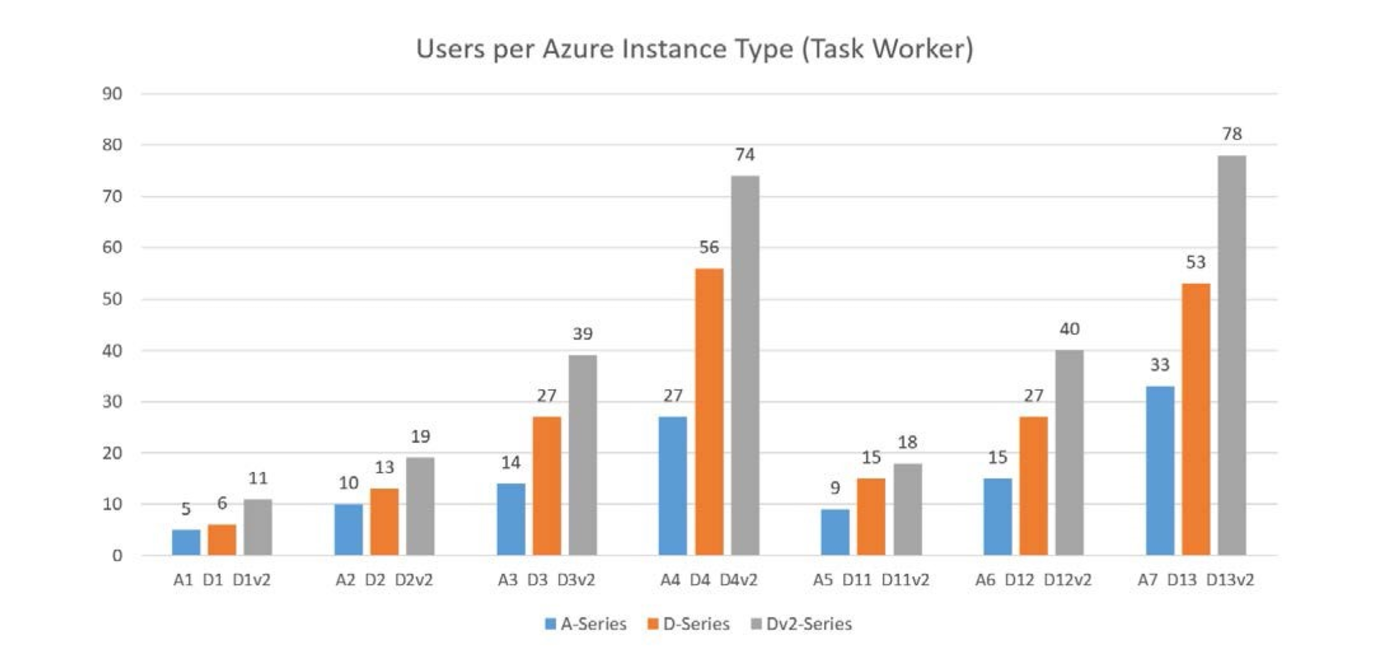
Work Work Profile Knowledge Worker : scripts were executed with operations in Microsoft Outlook, Word, PowerPoint, Excel, Adobe Acrobat, FreeMind, PhotoViewer, Doro PDF Writer, and also several videos were viewed at 360p resolution. With such a workload, higher demands are made on the performance of the environment.
Number of RAS users per Azure virtual machine:
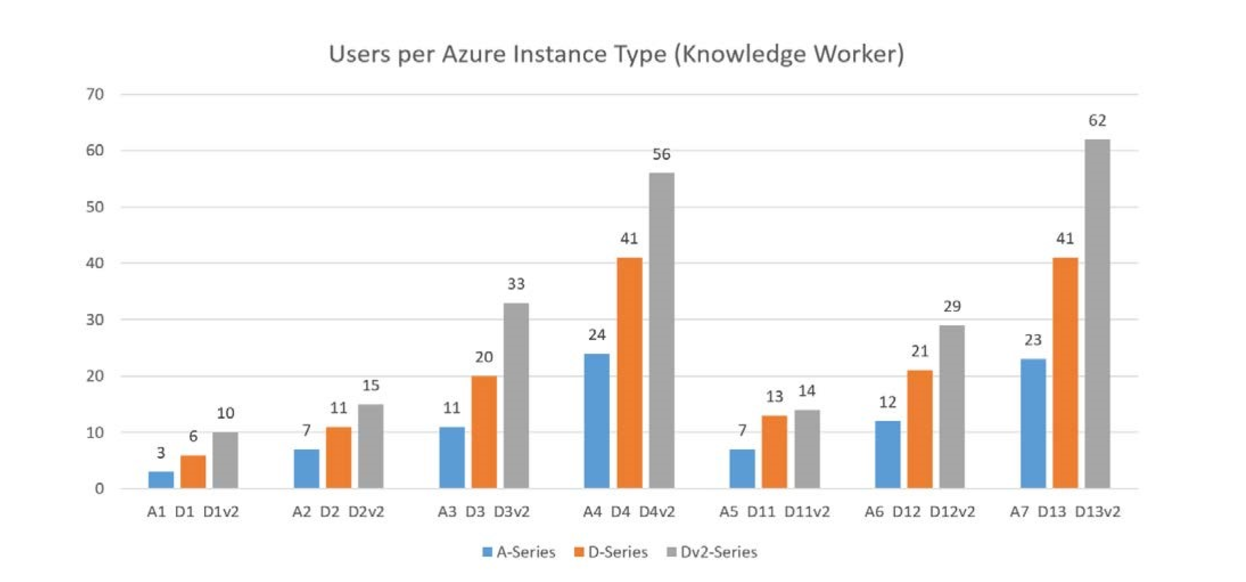
You can focus on these empirical data when choosing the number of virtual machines and scaling. Also, these data will help you assess the cost effectiveness of choosing a specific series of VM Azure, depending on your needs. Thus, for tens and hundreds of users, switching to RAS in Azure can be an interesting and effective way of automating VDI while reducing costs and support efforts
But we emphasize - this is only an approximate guide. If 41 users are indicated on a graph for a VM, this does not mean that it will be impossible to work with connection 42. It all depends on the specific nature of the load and performance requirements.
We invite "immigrants" with Citrix
You can write an entire research paper with a detailed explanation of why it makes sense to migrate from Citrix to RAS. But it seems that it will be interesting only to a small group of readers, half of which are marketers of both companies. Therefore, in brief we will list our arguments (sorry, it's hard to resist):
- RAS is about 60% more economical in terms of equipment costs, software licenses and employee training. With an equal RAS level, less resources are required, and it is easier to use.
- Adjustment and scaling of RAS is performed in a few clicks (we checked!) In the central configuration panel. The license includes all necessary components. For daily use of RAS, it is not necessary to allocate specially trained people; it is on the shoulder to any sysadmin.
- Longer life cycle and backward compatibility. Citrix no longer supports Windows Server 2003, it is no longer planned to release upgrades for most existing copies of Citrix XenApp. So upgrading your Citrix will still result in a full migration. On the other hand, we have a stable program of upgrades, and the entire infrastructure is updated in a few minutes with a single click. RAS supports Windows 2003, 2008 and 2012 Servers, so you can use mixed farm farms.
Conclusion
All of the above, we tried to convince you that the combination of Parallels RAS and Microsoft Azure, in our humble (hum) opinion, is an example of synergy: they complement each other, and together we have a universal, convenient, fast and easy-to-use solution for publishing. desktop Windows applications to any mobile device, without a headache in the form of creating hardware infrastructure and ensuring high availability.

ZY You can check for yourself: RAS can be driven for a month for free.
Source: https://habr.com/ru/post/325724/
All Articles